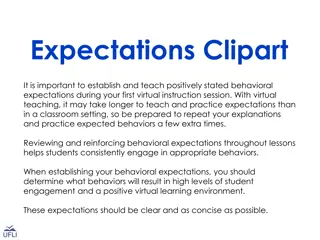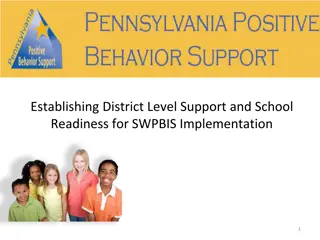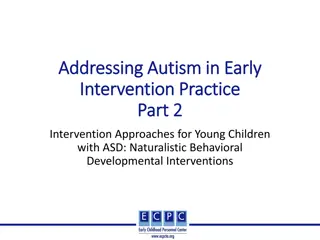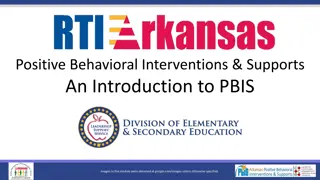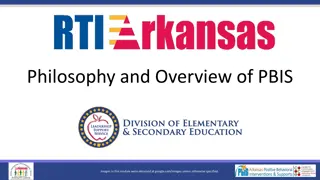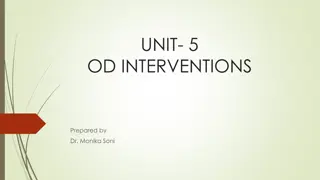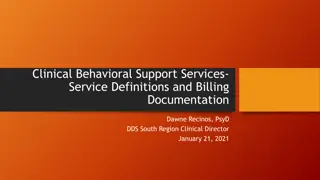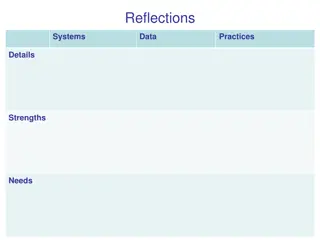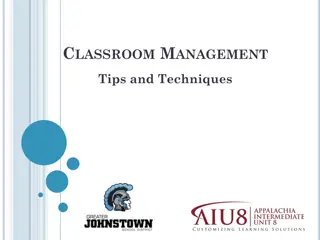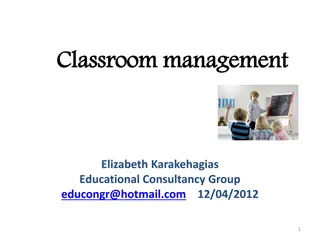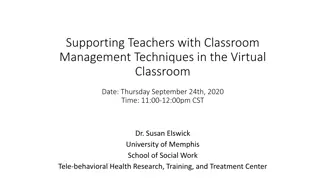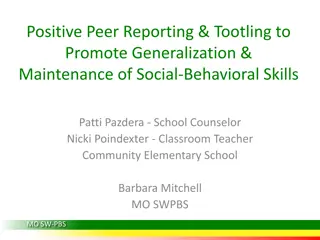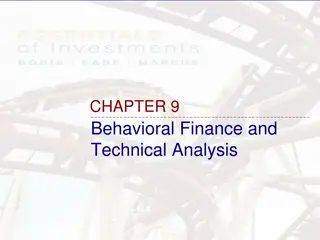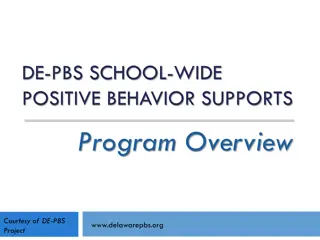Positive Behavioral Interventions and Supports in Classroom Management
Effective classroom management strategies, as outlined by the Midwest PBIS Network, play a crucial role in promoting positive student outcomes, preventing behavioral issues, and creating a safe learning environment. The focus on student engagement and proactive approaches enhances academic instruction and minimizes time spent on reactive behavioral management. Implementing PBIS practices results in better classroom climates and supports all students in their learning journey.
Download Presentation

Please find below an Image/Link to download the presentation.
The content on the website is provided AS IS for your information and personal use only. It may not be sold, licensed, or shared on other websites without obtaining consent from the author. Download presentation by click this link. If you encounter any issues during the download, it is possible that the publisher has removed the file from their server.
E N D
Presentation Transcript
PBIS Classroom* Materials modified from the Midwest PBIS Network *Classroom is not limited to traditional classroom spaces. It is any space where instruction takes place.
6 Classroom Practices 1. Physical environment 2. Classroom Teaching Matrix (Expectations, Rules, Routines) 3. Active Supervision 4. Encouraging Appropriate Behavior Direct instruction of expectations, rules, routines Preventative Prompts Specific Praise for Behavior Individual Reinforcers Class-Wide Group Contingency 5. Continuum of Response Strategies for Inappropriate Behaviors Praise other students/groups Specific Error Correction Etc. Rev 4-15-19. Midwest PBIS Network. Developed through the ongoing research and shared knowledge of many partners, including the National TA Center on PBIS, Midwest PBIS Network, Mid-Atlantic PBIS Network, Missouri PBIS, Lincoln Public Schools, Brandi Simonsen (UConn) & Diane Myers (Texas Women s University). 6. Engagement & Opportunities to Respond
Rationale Good Classroom Management is linked with: positive student outcomes both academically and behaviorally increased risk of preventing more serious problems among at-risk students. supporting all students in the prevention of possible current and future behavior problems. Strong management signals to kids that the class is a safe place to learn. Well managed classrooms are rated as having more positive climates. Bradshaw & Leaf, 2009) (Aber et el., 1998; Mitchell,
Student Engagement Most studies that measure effective teaching strategies use student engagement as the measure. Wong and others analyzed over 11,000 statistical findings to determine those factors that correlated the highest with student engagement, and rank ordered 28 variables. Classroom management was at the top of the list. Despite this statistic, only a third of teaching colleges teach classroom management.
What We Know Lack of discipline is one of the biggest problems facing public schools More time is being spent on reactive classroom and behavioral management and less time on academic instruction Effective Classroom Management strategies and practices implemented by teachers and support staff are the foundation of both behavior and academic interventions Maryland PBIS Network Information from
Positive Behavioral Interventions and Supports (PBIS) for Continuous Improvement and Alignment of Initiatives is a Multi-Tiered System of Supports (MTSS) Framework PBIS Supporting culturally equitable Targets including social/emotional competence & academic achievement OUTCOMES Supporting culturally knowledgeable Staff Behavior team-based leadership and coordination professional development, coaching, and content expertise Supporting culturally valid Data-based Decision Making universal screening progress monitoring evaluation of fidelity PRACTICES Midwest PBIS Network 2/7/19. Adapted from: What is a systems Approach in school-wide PBIS? OSEP Technical Assistance on Positive Behavioral Interventions and Supports. https://www.pbis.org/school Supporting Student Behavior three-tiered continuum of culturally relevant evidence-based interventions McIntosh, K.& Goodman, S. (2016). Integrated Multi- Tiered Systems of Support: Blending RTI and PBIS. New York: Guilford Press.
Installing Classroom Practices within the PBIS/MTSS OUTCOMES Increased Instructional Time Increased Relationships Positive Climate DATA SYSTEMS School-wide plan for teaching, installing, and coaching Classroom Practices Connecting to School- wide PBIS Components Tiger Pride Team Staff Self- Assessments Minor/Major ODRs PRACTICES Classroom Practices
Three-tiered Continuum of Evidence-based Practices Tier III Prevention: Specialized, Individualized Data, Systems, Practices for High-Need and Complex Behaviors ~5% Students Staff Families Community ~15% Tier II Prevention: Group-based Data, Systems, Practices Targeting At-Risk Behaviors Tier I Prevention: School/Classroom-wide Data, Systems, Practices for all Students, Staff, Settings ~80% responding Midwest PBIS Network 1-15-19 Adapted from: USDOE OSEP PBIS TA Center
Classroom Practices 6 Classroom Practices Classroom Practices 1. Physical environment 2. Classroom Teaching Matrix (Expectations, Rules, Routines) These classroom practices have been identified to improve the likelihood of appropriate behavior and decrease problem behavior, while increasing academic learning time. 3. Active Supervision 4. Encouraging Appropriate Behavior Direct instruction of expectations, rules, routines Preventative Prompts Specific Praise for Behavior Individual Reinforcers Class-Wide Group Contingency 5. Continuum of Response Strategies for Inappropriate Behaviors Praise other students/groups Specific Error Correction Etc. What do you think of this list? Any you would add/delete? 6. Engagement & Opportunities to Respond Rev 4-15-19. Midwest PBIS Network. Developed through the ongoing research and shared knowledge of many partners, including the National TA Center on PBIS, Midwest PBIS Network, Mid-Atlantic PBIS Network, Missouri PBIS, Lincoln Public Schools, Brandi Simonsen (UConn) & Diane Myers (Texas Women s University).
Tiered Fidelity Inventory TFI 1.8 Classroom Procedures: Tier 1 features (school-wide expectations, routines, acknowledgements, in-class continuum of consequences) are implemented within classrooms and consistent with school-wide systems. How has the school-wide system translated to classrooms?
Office Discipline Referrals When the majority of referrals come from the classroom setting, behavior is interfering with students academic learning and engagement
Office Discipline Referrals Since September 2005 Classroom Referrals
Office Discipline Referrals Since September 2005 Classroom Referrals
Quick Activity Sample Rubric: 1 = Quite Poor 2 = Poor 3 = Good 4 = Very good So what is in a 4? You know more about them than just the basics The student would also rate you as someone helpful they can talk to They feel you care Other ideas??
Research-Based Benefits of Relationships DISCIPLINE : In a meta-analysis of more than 100 studies- teachers who had high-quality relationships with students had 31% fewer discipline problems, rule violations, and other related problems over a year s time than did teachers who did not (Marzano, Marzano, and Pickering 2003) LEARNING OUTCOMES : John Hattie s Visible Learning research is based on a meta-analysis of 800 studies where he ranked 138 influences on student learning. The average effect size of all influences studied was .40. Teacher- Student relationship had an effect size of .72, which is in the high zone of desired effects. (just below feedback - .73) : The single most common factor for children who develop resilience is at least one stable and committed relationship with a supportive parent, caregiver, or other adult (Center on the Developing Child at Harvard University) RESILIENCY
Relationship = Key to Success One stable and committed adult relationship National Scientific Council on the Developing Child (2015). Supportive Relationships and Active Skill-Building Strengthen the Foundations of Resilience. Harvard University. Teacher-Student Relationship has a .72 effect size on student learning Average effect size of all interventions studied was .40 Hattie. J. (2009). Visible learning: A synthesis of over 800 meta-analyses relating to achievement. London: Routledge.
Data from our 2019 Student Survey Percentage
Data from our 2019 Student Survey Percentage 605 students surveyed 183 not enjoying and 54 of those not feeling connect to at least one staff member.
Self-Assessment (we will maintain confidentiality) Think of the student who you identified earlier 1. Determine what failure factors are relevant to the identified student (e.g. attendance, behavior, academic/social performance, etc.) CASEL SEL competencies 1. What SEL skills might be missing? (e.g. self- awareness, self-management, social- awareness, interpersonal skills, decision- making, responsible behaviors) Third Grade Second Step Scope and Sequence Fourth Grade Second Step Scope and Sequence Fifth Grade Second Step Scope and Sequence 1. Identify 1-2 things you can do to improve that relationship, and how you can teach those missing skills. Classroom Matrix Template 1. Discuss
How do PBIS classroom practices support the Trauma lens? Kids don t care what you know until they know that you care.
Bottom-Up Development Adverse Experiences Typical Development Cognition Cognition Social/ Emotional Social/ Emotional Regulation Regulation Survival Survival Adapted from Holt & Jordan, Ohio Dept. of Education
What to Expect In Our Classrooms 13 of every 30 students in a classroom experience toxic stress from 3 or more Adverse Childhood Experiences (ACEs) 11 students in charids Source: Washington State Family Policy Council
What Flight, Fight, or Freeze Looks Like in the Classroom Flight Fight Freeze Exhibiting numbness Refusing to answer Withdrawing Fleeing the classroom Acting out Behaving aggressively Acting silly Skipping class Refusing to get needs met Giving a blank look Feeling unable to move/act Daydreaming Seeming to sleep Exhibiting defiance Being hyperactive Avoiding others Hiding or wandering Becoming disengaged Arguing Screaming/yelling Fostering Resilient Learners Strategies for Creating a Trauma-Sensitive Classroom Kristin Souers with Pete Hall
Trauma Lens Crosswalk with the 6 Classroom Practices A well-designed classroom environment promotes of sense of safety and security for students impacted by trauma. 1. Physical Environment A well-designed teaching matrix creates consistency and predictability through clearly stated positive expectations with examples (rules). Routines support regulation, and can develop social-emotional competencies. 2. Classroom Teaching Matrix (Expectations, Rules, & Routines) Active supervision provides a sense of safety as well as frequent opportunities for relationship development for students impacted by trauma. 3. Active Supervision These practices (Behavior lesson plans, preventative prompts, specific praise, individual reinforcers, and group contingencies) teach and increase use of desired social-emotional competencies (e.g.: sense of self, emotional regulation) often underdeveloped in students impacted by trauma. 4. Encouraging Appropriate Behavior 5. Continuum of Responses to Inappropriate Behavior The continuum of response provides opportunity to use trauma informed strategies to help the student regulate, connect (relate) with the adult, and allows the student to access their problem-solving skills (reason). 6. Engagement & Opportunities to Respond Facilitating frequent opportunities for students to respond provides time to process or apply what students are learning, allowing neural networks to be strengthened. (Craig, S.E., 2016) Rev 2-15-19. Midwest PBIS Network.
Self-Assessment your current classroom Step 1: Rate your overall classroom behavior on a scale of 1-5. 1 = off-task, disruptions, low prosocial skills 5 = academically engaged, effective routines, respectful behavior to each other and teacher, pro-social skills
Self-Assessment your current classroom Step 2: With your 1-5 rating in mind, reflect on your practices, and consider these questions: Do my students know my expectations? Do my students know the routines for the classroom? Do my students feel comfortable and safe in my classroom? Do I acknowledge my students good behavior? Do I know how to handle inappropriate behavior? Step 3: Discuss with partner or table
Self-Assessment of 6 Classroom Practices On your own Classroom Practices Tool - Classroom Practices Rubrics Reflect on the questions in each area to determine focus area(s).
Classroom-wide PBIS These are proven components of successful Tiger Pride classrooms. The six practices were developed by the Midwest PBIS Network. Everyone will develop their classroom matrix. We encourage collaboration across teams and grade levels. Use the other resources to as needed to create your positive classroom environment. Classroom Practices - Rubrics (taken from each Practice link below) Physical Environment - Practice 1 Matrix - Classroom Teaching Matrix - Practice 2 (Classroom Matrix Template, Routines and procedures examples, Previous Classroom Routines template) Place completed matrix in Classroom Matrix Folder Active Supervision - Practice 3 Encouraging Appropriate Behavior - Practice 4 Continuum of Responses to Inappropriate Behavior - Practice 5 Nine variables that affect compliance Error correction strategies Engagement and Opportunities to Respond - Practice 6 Classroom Management Self-Assessment Classroom Management Survey Powerpoint with examples for each practice
Resources National Website http://www.pbis.org/school/pbis-in-the-classroom Midwest PBIS Classroom Modules http://www.midwestpbis.org/materials/classroom-management Florida PBIS Classroom Coaching http://www.livebinders.com/play/play?id=2295063 Mid-Atlantic PBIS http://www.midatlanticpbis.org/materials-1/classroom Additional Classroom Resources Tim Lewis https://www.pbis.org/resource/192/classroom-checklists-effective-classroom- plan-environmental-inventory-checklist Supporting and Responding to Classroom Behavior Tool http://www.pbis.org/resource/1016/supporting-and-responding-to-behavior 5A Classroom (TFI 1.8)



